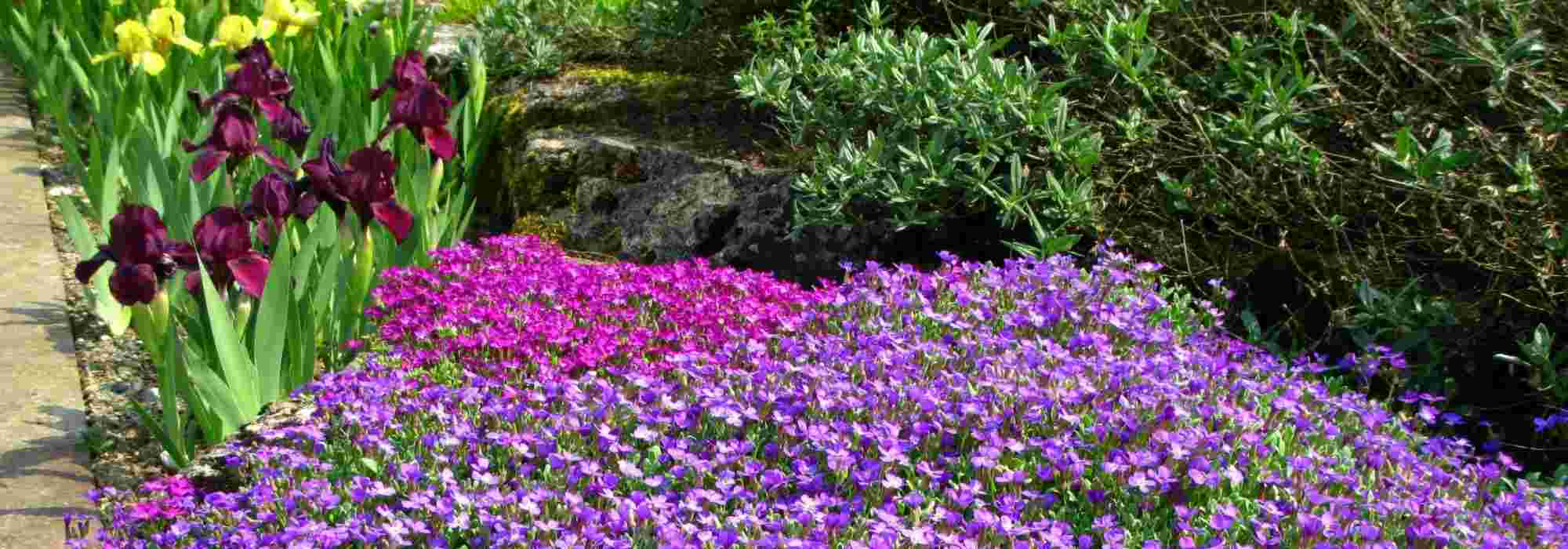
Aubrieta: pairing ideas
6 inspiration ideas
Contents
At the end of winter, the desire for colour becomes apparent. Fortunately, at a height of 10-15 cm, the Aubrieta is here with the arrival of spring and fine days to brighten our green spaces. Forming very floriferous cushions, its colours are vibrant: white, purple, blue, or pink almost red! In addition to being very hardy, it is also decorative during the winter period when it retains its foliage. This low perennial is very easy to grow and maintain, as long as it is in a sunny position and in light, well-drained, and rather calcareous soil. It is an ideal ground cover for beginner gardeners who can use it in borders, rockeries, troughs, and pots, or to adorn a wall. The most well-known is Aubrieta deltoidea, but there are many others. Discover our ideas for combinations for 6 different varieties.
For more information, feel free to check our article on Aubrieta, Aubrieta: sowing, planting, growing.
Different Aubrietas are available online on our site.
At the foot of a bed of shrubs and perennials
Aubrietas can be perfectly planted under bushes, accompanied by perennials. For this, plan for 5 to 7 young plants per square metre. Of course, Aubrieta being very low, it must be placed in the foreground so that it is not hidden by other plants. Let’s start with the taller ones. In the background, shrubs not exceeding 1.5 m in height such as Prunus glandulosa ‘Alba Plena’ with double flowers, Deutzia ‘Raspberry Sundae’ with clusters of large bicoloured flowers, and the dwarf Lilac Syringa meyeri ‘Flowerfesta White’ take their place to add rhythm to the bed. In front of them, a few garden Irises bring touches of colour such as Iris germanica ‘Mary Frances’ and ‘Ruffled Goddess’. Upright Alliums on their stems join this scene: Allium carolinianum ‘Rosy Dream’ with well-rounded inflorescences tinged with mauve pink and Allium sikkimense dusted with blue-grey. Finally, Dianthus plumarius ‘Scent First Memories’ in immaculate white brightens this bed and highlights the lilac blue of Aubrieta ‘Cascade Blue’.
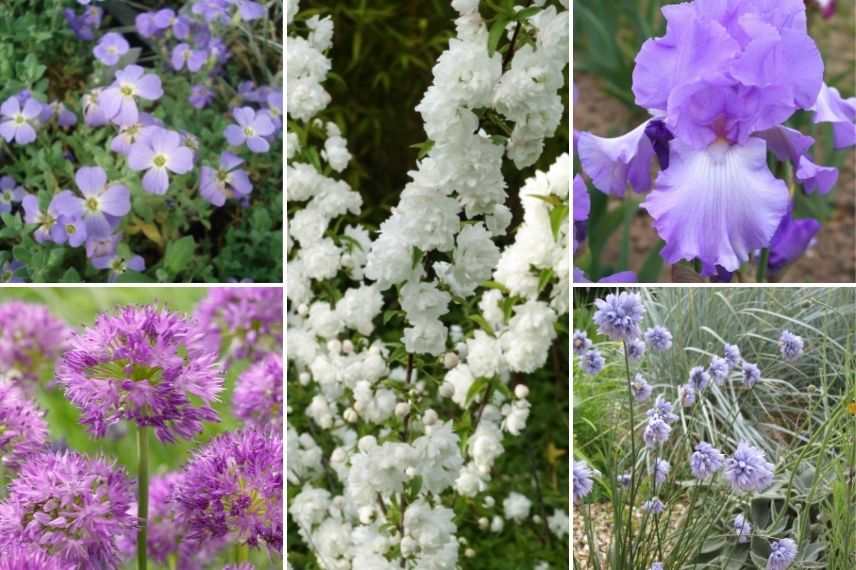
Aubrieta ‘Cascade Blue’, centre Prunus ‘Alba Plena’, Iris germanica ‘Mary Frances’, Allium ‘Rosy Dream’ and Allium sikkimense
Discover also our selection of 7 ideal perennials for border planting.
Read also
How to build a dry stone wall?In dry rockery
Aubrieta is perfect for rockeries. Its evergreen foliage is decorative all year round, and in spring, its abundant flowering is ideal for dressing up spaces. Moreover, Aubrieta requires little maintenance. To create a proper rockery, it is essential to choose plants that thrive in well-draining substrates, such as succulents, herbs, coastal plants, and alpine perennials. Aubrieta ‘Fiona’, literally described as a flowering carpet, spreads up to sixty centimetres wide and only reaches 5 cm in height! Its generous white flowering from April to May pairs well with Sedums and Houseleeks. These plants are perfectly at home in dry, warm rockeries, which they easily colonise. Grasses with arching clumps also thrive there. Currently very trendy, Stipa tenuifolia and Stipa barbata look great all year round, even with very little maintenance. The lightness of the grasses contrasts well with the hardness of the large stones in the rockery. Larger perennials, such as Lavender, Phlomis, and Cistus, which tolerate dry and poor conditions, add volume to the overall display. It is advisable to plant them at a distance from other plants to give them the necessary space for their development.
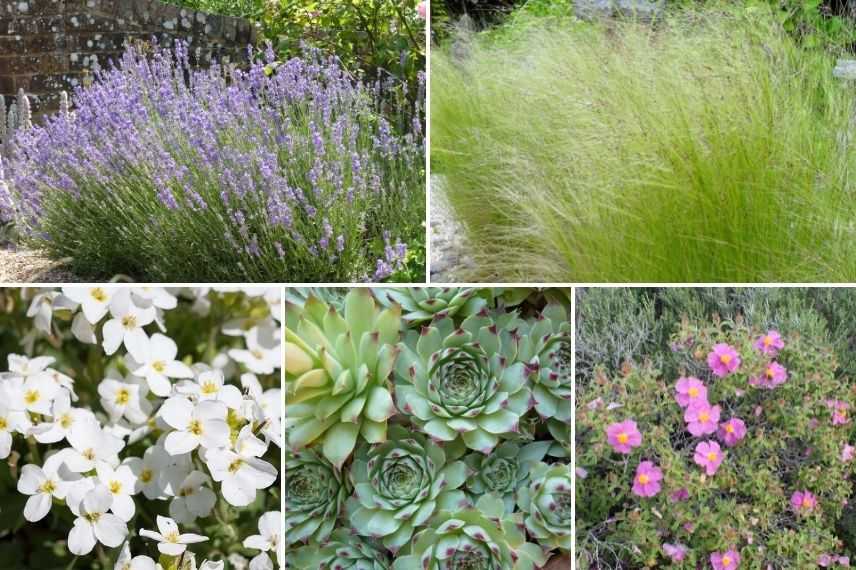
Lavandula angustifolia ‘Munstead’, Stipa tenuifolia, Aubrieta ‘Fiona’, Sempervivum calcareum, and Cistus creticus (photo Kenraiz)
Everything you need to know to create a rockery: our tips for success.
Read our article: 15 plants for creating a sunny rockery
Discover other Aubrieta - Rock Cress
View all →Available in 2 sizes
Available in 1 sizes
Available in 0 sizes
Available in 1 sizes
Available in 1 sizes
Available in 1 sizes
Available in 1 sizes
Available in 1 sizes
Available in 1 sizes
Available in 1 sizes
On a a low wall
Aubrieta is the ideal plant for flowering a wall in a sunny position. It forms magnificent flowering cushions that cascade down. The Aubrieta ‘Red Carpet’ graces the top of a wall alongside Erigeron karvinskianus, which is not afraid of poor soils and drought. To cover a slope or a wall, Cerastium tomentosum ‘Yo Yo’ perfectly fulfills its role. Very floriferous, it forms a grey and white carpet from May to July. The very hardy Aster alpinus ‘Dunkle Schöne’ fills empty spaces by producing a grassy tuft. Easy to grow and maintain, hardy geraniums adorn walls while resisting summer drought. An excellent ground cover, Phlox subulata or moss phlox, also enjoys sunny and dry conditions. Finally, perched at the top, the garden valerian adds rhythm to this scene with its upright habit.
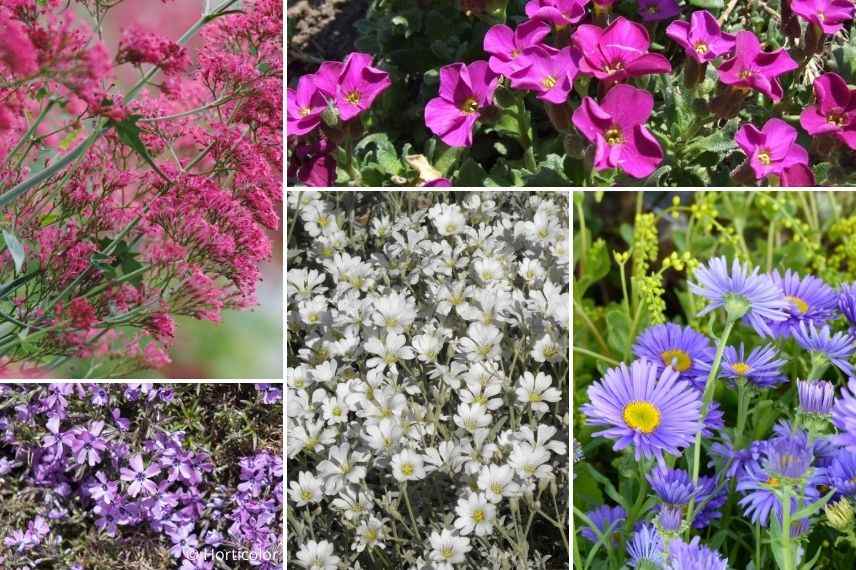
Centranthus ruber (photo snapp3r), Aubrieta ‘Red Carpet’ (photo Wikipedia), Phlox subulata ‘Purple Beauty’, Cerastium tomentosum ‘Yo Yo’ (photo Wikipedia) and Aster alpinus ‘Dunkle Schöne’
To learn more, visit our articles: how to flower a wall and 10 perennial plants to enhance a wall.
In a spring bulb border
To highlight and enhance a pathway, Aubrieta paired with spring bulbs is an excellent combination. Easily weaving between its neighbouring plants to form a dense and colourful carpet, the Aubrieta mauve ‘Dr Mules Variegated’ creates a beautiful colour contrast from March onwards, alongside yellow Narcissi, of which there are many species and varieties! To add even more appeal to this border, plant Hyacinths such as Hyacinthus orientalis ‘Madame Sophie’ that fill the air with their delightful fragrance. A true olfactory pleasure! Opt for Crocus vernus, which bloom slightly later than botanical Crocuses. Muscaris are also welcome. And rather than choosing a classic blue Muscari, select the small Muscari macrocarpum ‘Golden Fragrance’ that brings a touch of originality with its bicoloured yellow and purple flowers!
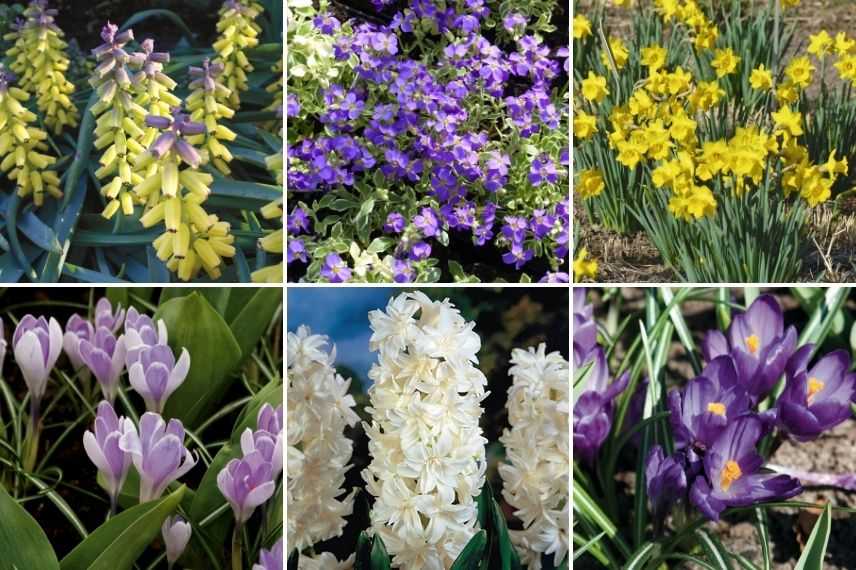 Muscari ‘Golden Fragrance’, Aubrieta ‘Dr Mules Variegated’, Narcissus pseudonarcissus ‘Obvallaris’, Crocus vernus ‘Vanguard’, Hyacinthus ‘Madame Sophie’ and Crocus vernus ‘Flower Record’
Muscari ‘Golden Fragrance’, Aubrieta ‘Dr Mules Variegated’, Narcissus pseudonarcissus ‘Obvallaris’, Crocus vernus ‘Vanguard’, Hyacinthus ‘Madame Sophie’ and Crocus vernus ‘Flower Record’
Discover our wide range of spring bulbs!
For bulb planting: all our tips for choosing the right tools.
To enhance a monochrome flowerbed
Synonymous with daydreaming and calm, purple is a colour conducive to meditation in the garden. Thanks to its hues, Aubrieta integrates very well into a setting of purple and mauve tones. The tallest perennials should be placed at the back of the border: the all-rounder Baptisia ‘Purple Smoke’ (or Indigo Lupin) takes time to establish but is very robust, and the Iris germanica ‘Carl and Sissy’ which exceeds 1 m in height during flowering. A bit smaller, the Geranium pratense ‘Cloud Nine’ produces a perpetual flowering of double flowers borne on stems that can reach 80 cm in height. Next comes the Mountain Cornflower with its wild style, but with such graphic flowers! To add an herbaceous touch, intersperse here and there the Deschampsia, a grass with a very natural style. Finally, the Iberis ‘Absolutely Amethyst’ blends with the Aubrieta ‘Cascade Purple’ at the front of the border.
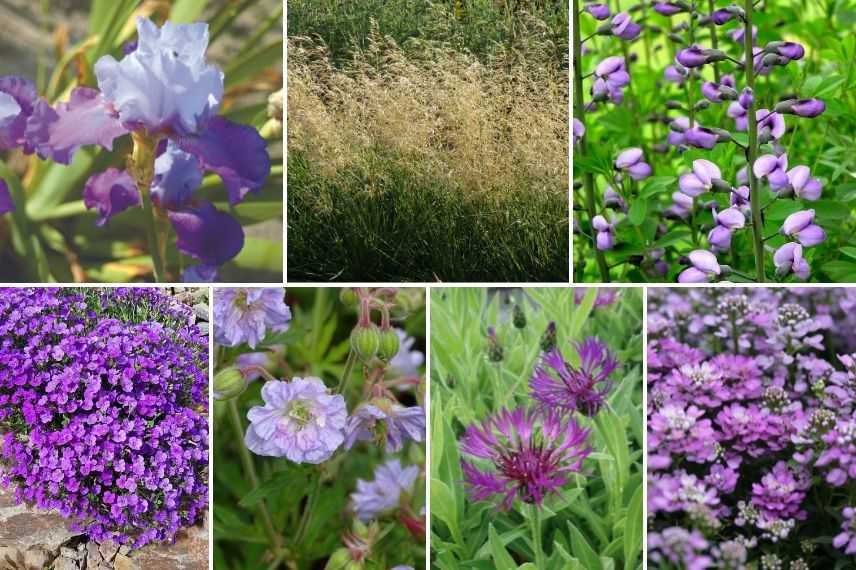
Iris germanica ‘Carl and Sissy’, Deschampsia caespitosa ‘Goldtau’, Baptisia ‘Purple Smoke’ (photo normanack), Aubrieta ‘Cascade Purple’ (photo Emer3), Geranium ‘Cloud Nine’, Centaurea montana ‘Violetta’ and Iberis ‘Absolutely Amethyst’
In a trough or in a large container
Aubrieta is also suitable for planting in a trough or large container where it can be combined with other perennials or annual plants. Position it near the edge to create a beautiful floral carpet cascading from its container. Avoid overcrowding the trough so that each plant has enough space to grow. The Aubrieta ‘Florado Rose-Red’ pairs its pink flowers with the soft, silver foliage of Artemisia stelleriana ‘Boughton Silver’. In a well-draining substrate, the robust and very low Saxifrage moss ‘Pixie’, an alpine rock plant, also feels at home. Finally, some large-flowered pink tulips like Tulipa double early ‘Foxtrot’ take centre stage in the composition. Alongside this, Erysimum ‘Constant Cheer’ also adds some volume to this arrangement. If desired, you can replace the previous plants with Garden Primroses, Pansies, and Myosotis planted as biennials.
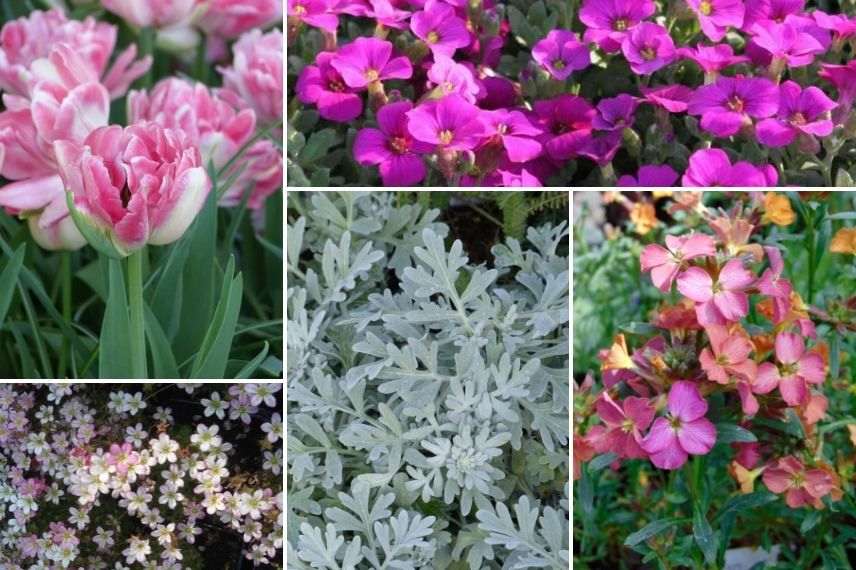
Tulip ‘Foxtrot’, Aubrieta ‘Florado Rose-Red’, Saxifraga ‘Pixie’, Artemisia stelleriana ‘Boughton Silver’ and Erysimum ‘Constant Cheer’
- Subscribe!
- Contents
![[plant id="1234" name="Aubrieta"]](https://en.promessedefleurs.eu/blogwp/wp-content/uploads/2021/08/Associer-Aubriete.jpg)































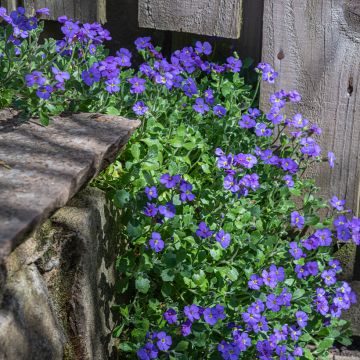
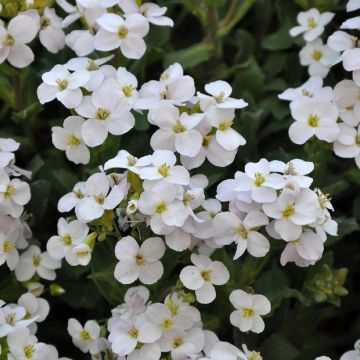
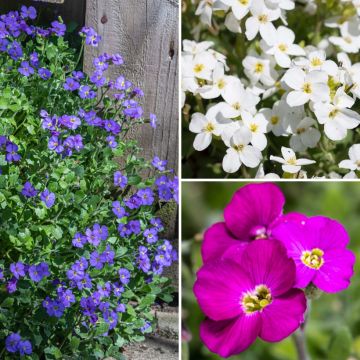
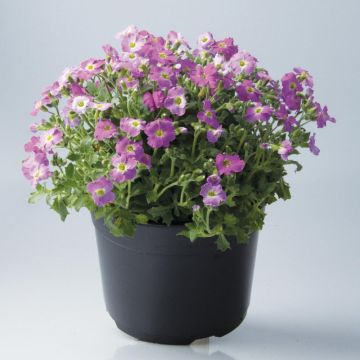
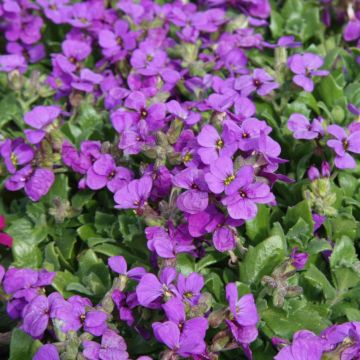
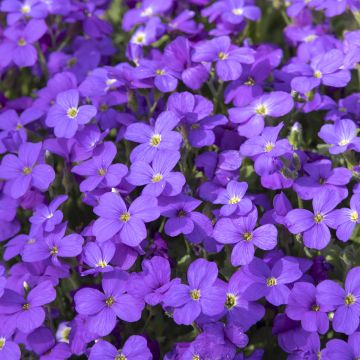
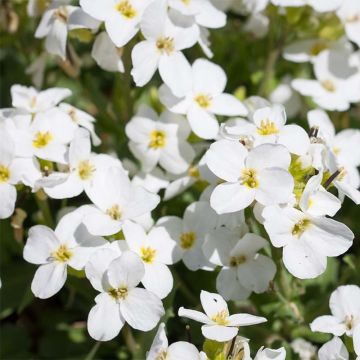
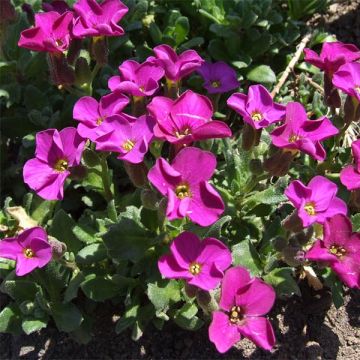
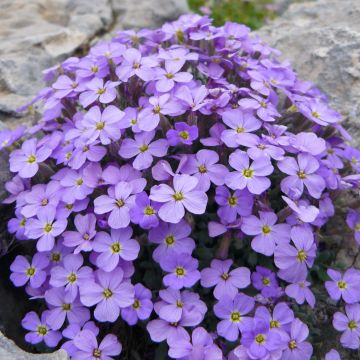
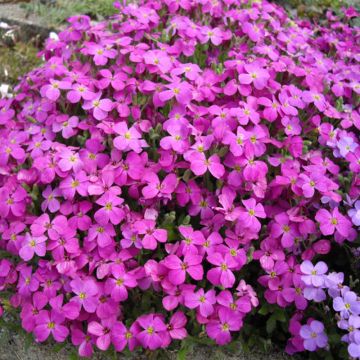
Comments